24.05.2005
М.Dvoretsky. Practical psychology
A psychological struggle is an integral part of a chess game. It's been a long since this statement goes without saying. Though I’m not sure that we realize clearly how a psychological factor peeps in chess and what is to be done to make progress in this field. I would point out three main trends here – in the decreasing order of importance.
1) Personal psychology – it’s necessary to analyze features of your own mentality, your conduct over the board and in ordinary life, to discover weaknesses and get rid of them. Introspection is difficult for many players – in such cases a help of highly skilled coach is desirable.
2) Psychology of the "abstract opponent" – understanding of standard reactions of the majority of the chess players in particular situations, opening up the new methods of struggle that will be mostly unpleasant and embarrassing for the opponent. Effective studying of any serious problem contains a psychological aspect; many chess principles are chess-psychological. You can see it yourself in the corresponding chapters of my books devoted to the conversion of advantage (' Technique for the Tournament Player') or the defense of difficult positions (Tactical Play: School of Chess Excellence 2).
3) Taking into account a character and a manner of play of a certain opponent.
Why do I consider the third aspect to be less important? The point is that we use it quite superficially – we take into consideration a fact that our opponent is not fond of defending, that he feels shaky in the ending or in the closed positions, that he is afraid of eminent opponents etc., - even this information is not very often used. At the same time, first two aspects require a deeper vision of different nuances of mentality, and a progress in this field will tell on your play in almost every game.
By the way a wide-spread opinion that Emanuel Lasker was a great psychologist, who analyzed and expertly used the weaknesses of his opponents, is not proved and is a myth in many respects. Once I gleaned and analyzed a lot of examples demonstrating how Lasker was fighting in difficult positions, at first I was embarrassed with the fact that I’d never seen a vestige of response to a certain weaknesses of his opponents. Finally I realized that I don’t find it because there was no such one. Lasker is a great fighter, and everything was all right with his own psychology, he understood perfectly how to create maximum difficulties for the opponent. He was fighting not only against the pieces but also against a person, but e name of the person rarely influenced his decisions. I’ve recently got acquainted with an article of pundit, professor and grandmaster Robert Huebner, in which he expressed a similar opinion about Lasker.
How knowledge and skills of practical psychology can be accumulated? To begin with, it would be nice to read about the problems that faced other chessplayers and the ways of their solving. For this purpose it’s useful to read grandmasters’ (and not only grandmasters’) annotations of their own games, in which they frankly impart their thoughts and feelings.
An encounter that is brought to your notice is a good food for psychological reflections. As in the recently published game Tal – Botvinnik you will be able to compare annotations of two outstanding grandmasters, which are full not only of purely chess analysis but also of different aspects of conducting the struggle. This is certainly not a manual in which simple truth is chewed over – critical perception of the things you will read, ability to compare, to catch the essence and to draw your own conclusions will be required of you. It’s useful to compare grandmasters’ ideas to other examples on the same subject that you came across before. For instance, compare Kasparov’s reaction to the unexpectedness in the opening, time consumption to the actions of Korchnoi in the similar situation against Karpov in Bagio (I’ve recently annotated this game on this website ).
The material that is brought to your notice will have the same format as the previous one (about encounter Korchnoi – Karpov) in the form of 'a game with questions', or 'solitaire chess'. You are to solve ten problems (objectively – far less difficult than in the previous article) – the answers are in the second part of the article.
Kasparov – Korchnoi
London 1983, the first game of the Candidate semifinal match
Annotations of Garry Kasparov and Victor Korchnoi were used (marked with different prints)
1.d2-d4 ¤g8-f6
2.c2-c4 e7-e6
3.¤g1-f3 b7-b6
4.¤b1-c3 Ґc8-b7
5.a2-a3 d7-d5
6.c4:d5 ¤f6:d5
7.e2-e3 g7-g6!?
I’ve found the right way of realization of this idea shortly before the match. Even in September of the same year I played 7...Ґ:c3 8.bcg6. Basically, it’s wrong to strengthen the center of White, but anyway I defeated Virtenzon and Tal. The latter game was played in the presence of Kasparov in the grandmaster tournament in Niksic and it’s clear that it attracted his attention. That’s why I played 7...g6 and this move came as a surprise to him, the time spent for thinking in the opening is the evidence of this fact (Korchnoi).
I’ve never studied seriously the move 7...g6, it’s difficult to say why. Most probably because there were enough problems in other variations. Nevertheless I managed to remember something: games Timman – Short (1982), Ftacnik – Adorjan (1983)... I recalled the game I had seen myself in a blitz tournament in Herzog-Novi, 1983 – Tal – Korchnoi!! By the way, it was won by Black. It’s clear that such recollections do not revive spirits during the game (Kasparov).
8.Ґf1-b5+
8.h4!? and 8.¤:d5!? were used more frequently later.
Having thought for a while I took a path, which is usual in case of 7...Ґe7, though I realized that moving a bishop on g7 may play into the hands of Black.
8. ... c7-c6
9.Ґb5-d3
9.Ґa4, 9.Ґc4, 9.¤:d5 were also played.
9. ... Ґf8-g7
10.e3-e4
10.0-0 0-0 11 gives no advantage to White.¤:d5 cd= (Tarjan – Adorjan, Vrsac 1983).
10. ... ¤d5:c3
11.b2:c3 c6-c5!
11...0-0 was also played, but the move that was made in the game is more active.
Fianchettoed bishops of Black violently fire at the opponent’s center. Essentially, there arose an advantageous for Black variation of the Gruenfeld defense.
12.Ґc1-g5
12.Ґb5+ Ґc6 13.Ґ:c6+ ¤:c6 14.Ґe3 leads to equality (Ftacnik).
It’s pleasant to develop a piece with tempo, but safer is 12.Ґe3!? 0-0 13.0-0.
12. . . . Јd8-d6!
12...Јc7 is also acceptable. Black does not want to take the attack off the d4, having every reason to believe that the win of another tempo will not be advantageous for White.
13.e4-e5 Јd6-d7
John Van der Wiel’s recommendation was also noteworthy: 13...Јd5.
I analyzed this position at home and came to a conclusion that after 14.0-0 0-0 15.¦e1 cd 16.cd ¤c6 there is nothing to complain about especially because the arisen situation strongly resembles the Gruenfeld defense in which I’m quite experienced. I expected that it would be more difficult for my opponent to orientate in this delicate situation than for me. It really happened that way...
After 14.0-0 0-0 Van der Wiel suggests 15.Јd2 cd 16.cd ¤c6 17.Јf4›, while Kasparov gives: 15.Јe2 cd 16.cd ¤c6 17.Јe3 or 17.Ґe4 – the position is difficult, but White is out of danger.
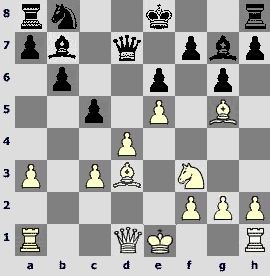
1) Evaluate 14.dc.
14.d4:c5 0-0
15.c5:b6 a7:b6
16.0-0 Јd7-c7
As Kasparov noted 16...¤c6? 17.Ґe4 Јc7 18.Ґf6! Ґ:f6 19.ef Јf4 20.Јb1! is wrong (probably even stronger is 20.Јd7!? Ј:e4 21.Ј:b7±). 16...¦a5!? suggested by Van Der Wiel was noteworthy.
Black got a possibility to put pressure on the weaknesses of White and a successful development of the pieces for a pawn. It’s clear that White won’t be able to keep a material advantage. Will he manage to break a harmonious development of Black?
Let’s examine different attempts of White.
17.¦e1
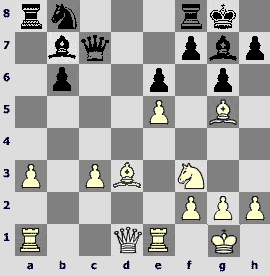
2) How should Black answer?
One more possibility: 17.Ґe2!? was not mentioned in grandmasters’ annotations.
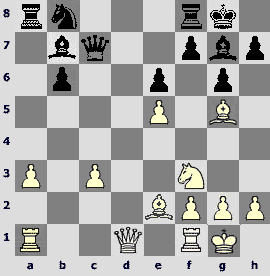
3) How should Black react?
17.Ґd3-b5!?
I decided to about-face the sort of the struggle. White immediately gives the important pawn e5 and tries to use the activity of his own pieces and a certain underdevelopment of Black.
Not least important detail: by this moment White had spent more than two hours while it took Korchnoi only 4 (!) minutes to make 15 first moves. However it took Black about 50 minutes to make the next move.
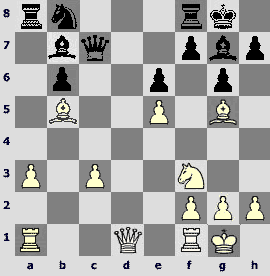
4) How should Black play?
17. ... Ґg7:e5
18.Ґg5-h6 Ґe5-g7?!
A very principled moment. Korchnoi tries to avoid all obscures and to decide the struggle by purely technical means. (A moot conclusion – he would hardly capture e5 pawn having chosen such an approach. It's Kasparov who is to be reproached with excessive caution and unreasonable evasion of complications in this game – see moves 8, 14, 21.)
I think it’s a cornerstone of Korchnoi’s match strategy to avoid complications, even favorable ones. He will undeviatingly follow this rule in the first eight games till the match situation makes him reverse the sort of the struggle.
19.Ґh6:g7 ўg8:g7
20.Јd1-d4+ ўg7-g8
20...f6 was the alternative, but the position of Black slightly weakens in this case, and such a perspective is not to Korchnoi’s liking.
20...f6? lets White attack victoriously. Korchnoi points the following variations: 21.¤g5 Јc8 22.¦ae1 e5 23.¦:e5! fe 24.Ј:e5+ ўh6 (24...ўg8 25.Јe7ќ) 25.¤e6ќ or 21...Јe7 22.¦ae1 e5 23.f4! fg 24.¦:e5 Јf6 25.fgќ.
Certainly, Black should not be in a hurry to capture the knight in the second variation. Instead of 23...fg? it’s correct to play 23...¤c6 24.Ј:b6 (24.Ґ:c6 Ґ:c6) 24...fg 25.Ґ:c6 Ґ:c6 26.Ј:c6 gf with unclear position.
White should probably try 22.¤h3!?, attacking the pawn b6.
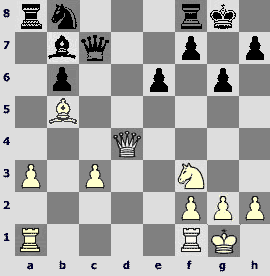
5) How should White continue?
21.¤f3-g5 h7-h6
22.¤g5-e4 Ґb7:e4
23.Јd4:e4 ¤b8-a6
It’s simple and good. After 23...¤d7 a double attack saves White 24.Ґ:d7 Ј:d7 25.Јe3, and now he is to choose the lesser of two evils.
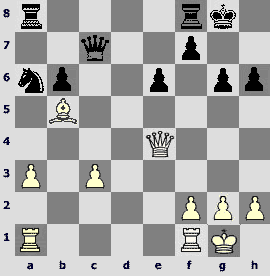
6) How should White play?
24.Јe4-e3 Јc7-c5
25.Јe3:c5 ¤a6:c5
26.¦f1-b1 ¦f8-d8
27.Ґb5-f1
Either 27.Ґc6 ¦ac8! 28.Ґf3 (28.¦:b6? ¦d6 29.Ґb7 ¦:b6 30.Ґ:c8 ¦c6, and the bishop is lost) 28...¦d6 29.a4 ¤d7 30.¦b3 ¦c5 with subsequent shift of the black king to the center and to the queenside.
27. ... ¦d8-d6
28.¦b1-b4 ўg8-f8
29.a3-a4?!
Most likely, it would be better to simplify – 29.¦ab1 ¦:a3 30.¦:b6 ¦:b6 31.¦:b6 ¦:c3, but, being short of time, it’s not easy to decide to venture upon such an important step. However, it’s even more difficult to defend the position when there are all pieces.
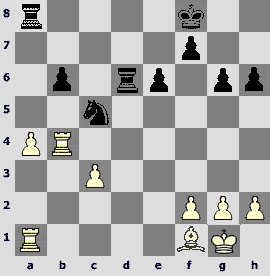
7) How should Black play?
29. ... ¦a8-a5
30.g2-g3
A bit more precise would be 30.Ґb5 or 30.Ґe2 with the idea to bring the king across f1 to the center.
30. ... ўf8-e7
31.ўg1-g2
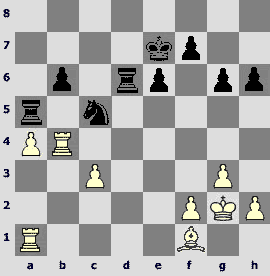
8) How should Black play?
31. ... f7-f5
32.Ґf1-b5 ¦d6-d2?!
A haste. Dynamic actions should be started after the king is moved on c7. Besides, Black had a good plan related to the advancement of the queenside pawns.
An absolutely right decision. It should be decided between 32...ўd8 and 32...g5. The fact, that Black violated a well known principle of the ending technique "don’t hurry", gave counter chances to the opponent, which he, however, did not use.
Let us consider the resources of White.
Passive moves like 33.¦f1? allow Black to return to the right plan – 33...ўd6! and ўc7. However, it is not exactly so: in reply to 33...ўd6? there is an unpleasant answer 34.Ґe8!. In case of 33...¦c2, one should play not 34.¦c4? ¦a8 and ¦d8 (Van der Wiel), but 34.Ґc6!. Perhaps Black would play 33...ўd8!? having control on the e8-square and being no afraid of 34.¦d4+?! ¦:d4 35.cd ¤:a4µ.
Both Kasparov and Korchnoi advise 33.Ґc6!?. 33...ўd6? 34.¦:b6 ўc735.¦b5 does not work. 33...¤d3 suggests itself, and bad is 34.¦d4? ¦:f2+ (34...e5!? 35.¦d7+ ўe6° with threatening of 36...¦:f2+, 36...¦c5 seems to be stronger) 35.ўg1 ¦d2 36.Ґb5 ¤e5!°. White calmly plays 34.¦:b6, and both 34...¤:f2 35.¦b5! (Kasparov) and 34...¦:f2+ 35.ўg1 ¦c2 36.¦b5 (36.¦b3 ¤c1) 36...¦a6 37.¦b7+ (37.Ґb7!? ¦a7 38.a5) 37...ўf6 38.Ґb5 ¦d6 39.¦d1 (39.a5? ¤e5°) 39...¦:c3 40.a5 ¤c5 41.¦:d6 (probably more precise is 41.¦f7+!? ў:f7 42.¦:d6) 41...¤:b7 42.¦a6 ¦a3 43.Ґc4 ¤c5 44.¦a8 (Korchnoi) guarantee him a sufficient counterplay because of the a-passer.
Finally, also possible is 33.¦ab1!? ¤e4 34.¦1b2 ¦:b2 35.¦:b2 ¤:c3 (35...ўd6 36.Ґd3=) 36.Ґc6 ўd6 (36...¤:a4 37.Ґ:a4 ¦:a4 38.¦:b6?; 36...¦a6 37.¦b3 ¤d5 38.Ґb7?) 37.¦:b6 ўc7 (or 37...ўc5) 38.¦b3 with a probable draw (Dvoretsky).
33.¦b4-d4
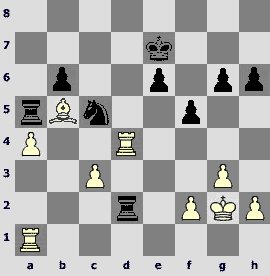
9) How should Black continue?
33. . . . ¦d2:d4
34.c3:d4 ¤c5:a4
35.¦a1:a4
It is the best practical chance. In reply to 35.Ґ:a4, one can answer by 35...b5 with an easy win, in case of 35.Ґc6 ¤c3 36.¦e1 ¦a2 the aim of Black is also not so difficult.
35. . . . ¦a5:b5
36.¦a4-a7+
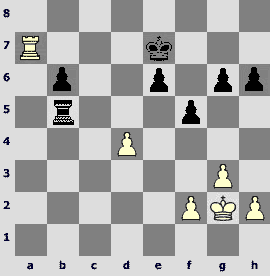
10) Where should the king retreat?
36. . . . ўe7-d6
37.¦a7-h7?!
The move h6-h5 is favorable for Black, therefore, one does not have to force him.
Arising Endspiel is fraught with several refinements, but the young grandmaster loses it just in two moves! The reason of it lies not only in the time trouble; I think the persistence in the defense is not the strongest part of Kasparov’s manner.
Both 37.ўf3 and 37.h4 would force Black to be more inventive to reach the victory.
We should say that in case of 37.ўf3 the plan of Black is clear: 37...¦b3+ 38.ўe2 b5 39.h4 h5 40.¦g7 ўd5 41.¦:g6 b4 42.¦h6 ¦b2+ 43.ўe3 b3. Now 44.¦:h5 does not work because of 44...¦e2+!, and Black promotes a pawn. Only the move 44.¦h8 remains possible. Then 44...¦c2! 45.¦b8 ўc4, and the b-pawn with a support of the king decides the game. Here there is a main variation: 46.¦c8+ ўb4 47.¦b8+ ўc3 48.¦c8+ ўb2 49.¦b8 ¦c4 50.ўf4 ¦:d4+ 51.ўg5 ўc3 52.ў:h5 b2 53.¦:b2 ў:b2 54.ўg5 ¦g4+ 55.ўf6 f4 56.ў:e6 ¦:g3.
It would be a very hard time for Black after 37.h4. The only evident answer is 37...h5 with an intention to move the pawn from the 6th rank, where it is subject to an attack of the rook. In this case the move 38.¦g7 is as bad as in the encounter: 38...¦d5 39.¦:g6 b5 40.ўf3 ¦:d4 41.¦h6 b4 42.¦:h5 (42.ўe3 ¦d5 43.¦:h5 f4+) 42...b3 43.¦h8 ўc7, and White is not able to delay the b-pawn.
However, after 37.h4 h5 the king’s move on f3 is better: 38.ўf3 ¦b3+? 39.ўf4 ¦d3 40.ўg5, and White does not risk to lose anymore. Right is 38...e5!. Then after 39.de+ ¦:e5 everything becomes hopeless for White: when the king is cut off, the black b-pawn easily queens. The situation is harder in case of 39.¦g7 ed 40.¦:g6+ ўd5! 41.¦g5 ўc4 42.¦:h5 ¦c5! 43.¦h8 b5 44.h5 b4 45.h6 b3 46.¦b8 ¦c7 or 46.h7 ¦c7, and Black wins.
Tempting 42...d3 would lead to great difficulties: 43.¦h6! ¦d5 (and after 43...d2? 44.ўe2 ўc3 45.f4! it is already Black and not White, who should think about a draw) 44.¦:b6 d2 45.¦b1 d1Ј+ 46.¦:d1 ¦:d1 47.ўf4 ¦f1? 48.ў:f5 ¦:f2+ 49.ўg6(e6) with a draw. Instead of 47...¦f1 right is 47...ўd5 48.ў:f5 ўd6, and Black should win. A detailed analysis of this position would occupy more than one page.
37. . . . h6-h5
38.¦h7-g7?!
And here possible is also 38.ўf3 with a transition to the aforementioned variation, though without tempo (h2-h4). Now the struggle is coming to the end.
38. . . . ¦b5-d5
39.¦g7:g6 b6-b5
40.ўg2-f3 b5-b4
It is a question of style: 40...¦:d4 would also win without troubles.
41.ўe3 (41.¦g8 ¦b5) 41...b3 42.ўd2 (42.ўd3 ¦b5°) 42...¦:d4+ 43.ўc3 b2 44.ў:b2 ¦d2+ 45.ўc3 ¦:f2 46.h4
In reply to 46.h3 one can play 46...h4 47.g4 ўe5 48.gf ¦:f5 with a capture of the h3-pawn; or 48.¦g5 ¦f3+ 49.ўd2 ўf4 50.¦h5 fg. Black captures the second pawn and does not allow the weakness of the pawns "f" and "h".
But 46...ўe5!? 47.ўd3 h4 seems to be better technically (Van Der Wiel).
46...f4!
Black either captures the second pawn, or creates connected passers.
47.¦g5 (47.¦h6 fg (47...f3?! 48.ўd3) 48.¦:h5 ¦f5! 49.¦h6 ўe5 50.¦g6 ўf4° ван дер Виль) 47...¦f3+ 48.ўd4 ¦:g3 49.¦:h5 ¦e3! 50.¦h6 ўe7 51.h5 e5+ 52.ўd5 f3. White resigned.
Answers
1. The move 14.dc? is a positional mistake that conveys the initiative to the opponent.
It is hard to understand this move. My opponent seems to have trusted the newspaper articles that describe me as a chessplayer who is clinging to the material and is ready to suffer a terrible attack for an extra pawn.
Nonsense! Perhaps, it happened formerly, but already 2o years ago I reassessed my views concerning chess play and from then on I am fighting (as far as it is possible!) for an initiative not yielding the most aggressive grandmasters.
Many commentators forthwith interpreted extremely wrong the reason of Kasparov’s unsuccessful play in this game:
...The young inexperienced chessplayer having faced a surprise in the opening wasted all his time to refute the opponent’s plan instead of finding a way to simplifications and draw. This logical construction has one disadvantage – it is far for the truth.
It is clear that White cannot reckon on an advantage (and one can hardly suspect the opponent to show a positional ignorance), when he have created pawn’s weaknesses by 14.dc. This move has an essential advantage – one captures a pawn and Black has to waste time and strength to win it back. And this, as I think, will allow White to set normally his pieces and equalize the game. On the whole, the train of my thoughts exactly coincided with the consequent rationalization advices of the annotators! Unfortunately...
Kasparov counted on 14...bc 15.Ґb5 Ґc6 16.a4, then only Black can have problems. However, Korchnoi sacrifices a pawn: 14...0-0! 15.cb ab, receiving an excellent play.
2. From afar I have planned 17.¦e1, counting on 17...¤c6 18.Ґe4 ¦a5 19.Ґf6 or 17...Ј:c3 18.Ґe7 ¦e8 19.Ґb4.
However, on the closer examination I found an interesting exchange sacrifice in two versions at the disposal of Black – 17...¤d7! 18.Ґe7 ¤:e5 19.Ґ:f8 ¤:f3+ 20.gf ¦:f8 or, and it seems to be stronger – 18...Ґ:f3! 19.gf (19.Ј:f3? ¤:e5 20.¦:e5 Ґ:e5 21.Ґ:f8 ¦:f8 with a winning of pawn) 19...Ґ:e5 20.Ґ:f8 ¦:f8. In spite of an extra exchange White has to solve very unpleasant problems in defense, while Black can strengthen his position almost without any risk.
Korchnoi proposes 17...Ґ:f3!? 18.Ј:f3 ¤d7 19.Ґf4 Ґ:e5µ or 19.Ґf6 Ґ:f6 20.ef Ј:c3µ. Perhaps White should answer by 19.Ґb5!? ¤:e5 20.Јg3, keeping an acceptable position. In the variation that was mentioned by Kasparov Black obtains more.
One can conclude that the move 17.¦e1?! is unsuccessful.
3. In reply to 17.Ґe2!? doubtful is 17...Ґ:e5?! 18.¤:e5 Ј:e5 19.Јd2 or 19.Ґe3 with an equal game of White. There is nothing in 17...¤d7 18.Ґe7 followed by Ґd6, or in 17...¤c6 18.Јd6. It seems that 17...¦a5!? is the best continuation.
4. The following variation is a mistake: 17...Ґ:f3?! 18.Ј:f3 ¦a5 19.a4 Ґ:e5 20.g3 Ј:c3 21.Ј:c3 Ґ:c3 22.¦ad1 (Korchnoi) or 22.¦ac1!? – White has an excellent game owing to disconnection of black rooks and weakness of the b6-pawn.
In reply to 17...¤c6 Korchnoi advises 18.Ґf6 ¤:e5 (he awards this move of White with an exclamation mark, and the response of Black with a question mark) 19.¤:e5 Ґ:f6 20.¤d7 with an advantage of White. However, one should continue the variation: 20...Ґ:c3, и 21.¤:f8 Ґ:a1 22.¤:e6 leads to an equality, and 21.¦c1!? ¦fd8 22.Јb3 ¦ac8 23.a4 Ґd5 24.Јa3 results in a strange position that is difficult to evaluate.
Kasparov examines 2 other answers:
18.Ґ:c6 Ґ:c6 19.Ґf6 Ґb5. He assigns an exclamation mark to the last move, and it is in vain: 20.Ґ:g7 ў:g7 21.¦e1 Ј:c3 22.Јd6?. Black would better play 19...Ґ:f6 20.ef ¦a5.
18.Јd6 (Kasparov thinks that this reaction to 17...¤c6 is the best) 18...Ґ:e5 19.Ј:c7 Ґ:c7 20.¦fd1? – the preponderance of Black would be only symbolic.
Korchnoi proposes 17...¤a6 (with an exclamation mark) 18.Ґf6 Ґ:f6 19.ef Ј:c3 20.Јd4 Ј:d4 21.¤:d4 ¤c7 22.¦fb1, and evaluates the position in the ending as an equal.
However, Black has a right to claim for more after the game move 17...Ґ:e5! that Korchnoi considers to be very doubtful.
Carelessness or relapse of a childhood disease?..
But probably I was right nevertheless and the luck both from an emotional and quite often from a practical point of view does not consist in the equality of the game.
A tactical basis of Black’s plan lies in a short variation 18.¤:e5? Ј:e5 (both white bishops are en prise) 19.Ґh6 Ј:b5 20.Јd4 e5 21.Јh4 ¤d7°.
In reply to 18.Ґh6 one should have played not as in the game: 18...Ґg7?! 19.Ґ:g7 ў:g7 20.Јd4+ with an unpleasant initiative of White, but 18...¦d8! almost forcing a queen’s sacrifice: 19.¤:e5! ¦:d1 20.¦a:d1.
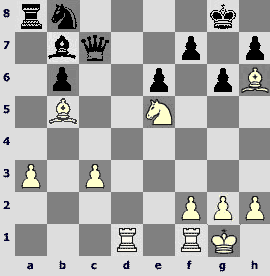
Kasparov analyses following variations:
20...f6? 21.¤d7! (unsuccessful is 21.Ґc4? fe 22.Ґ:e6+ ўh8 23.Ґg5 ўg7 24.¦d8 h6! 25.¦g8+ ўh7 26.Ґf6 ¤c6 (Kasparov) 27.¦:a8 Ґ:a8 28.¦d1 ¤d4! 29.cded°) 21...¤:d7 22.¦:d7 Јc5 23.¦g7+! ўh8 24.¦:b7 Ј:b5 25.Ґg7+ ўg8 26.Ґ:f6, and White has by no means a worse position.
20...Ґc6!? 21.c4 f6µ.
20...¤c6!? 21.¤g4¦d8! (21...Јe7?? 22.¦d7! is a mistake, however, the move 21...¦d8 by no means deserves an exclamation mark) 22.¤f6+ ўh8 – Black could gradually repel the threatening of the opponent and had quite good chances to convert his material advantage.
The last variation is inaccurate: instead of 22.¤f6+? White plays 22.Ґg5! ¤e7 (one cannot see something better) 23.c4, and the preponderance seems to be rather on his side. 21...¤e5! 22.¤f6+ ўh8µ strengthens the defense of Black.
Thus the bold capture of the e5-pawn promises to Black more than other, more cautious continuations do.
5. White has chosen a shy 21.¤g5?.
Kasparov loses his right way. The selection of a wrong route for a white knight completely justifies the fact that Black has refused entering the complications 3 moves before.
After 21...h6! 22.¤e4 Ґ:e4 (all the hopes for an attack disappear with a loss of this knight) 23.Ј:e4 ¤a6 Black has obtained a better position.
One should carry out a centralization regardless of anything –21.¤e5!, though a drastic continuation is related to a piece’s sacrifice. Unpleasant threats of ¤g4 and ¤c4 force Black to accept the challenge.
21...¦d8! 21...f6? 22.¤c4± or или 21...Јc5? 22.Ј:c5 bc 23.¦fd1± would lead to difficult for Black consequences. In reply to 21...¦a5 White answers not 22.¤g4 e5 23.¤:e5? ¦d8!°, but 22.c4 ¤c6 23.Ґ:c6 Ґ:c6 24.f4 f6 25.¤g4 ўg7? (variations of Korchnoi).
22.Јh4! ¦d5 23.¤g4 ¦:b5!
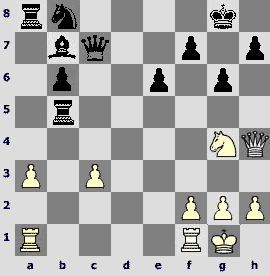
After 24.¤f6+ ўf8 25.Ј:h7 ўe7 26.¤g8+ ўe8 (26...ўd6!? – Dvoretsky) 27.¤f6+ White definitely has a draw – it seems to be very risky to move the king on the queen’s flank. Korchnoi is not right: 25...¤d7! is winning instead of 25...ўe7.
On the first glance it seems that Black manages to avoid dangers and keep a material advantage –24.¤f6+ ўf8 25.Јh6+ (25.¤:h7+ ўg7) 25...ўe7 26.¤g8+ ўd7 27.¦ad1+ Ґd5 28.Јf8 ўc6! 29.Јe8+ Јd7 and so on. Unfortunately I thought like this as well...
An analysis of Kasparov is inaccurate: after 27...Ґd5? White obtains an advantage by means of 28.c4! Ј:c4 29.¤f6+ ўe7 30.Јg5 (30.¤g8+ is enough for a draw) 30...ўf8 31.¦c1. Therefore, one has to play 27...ўc6! keeping chances to repel successfully an attack. However, even if there was nothing better for White during the following game, it seems to my, that anyway a sharp play promised him more practical chances than the cheerless position arisen in the encounter. Moreover, one manages to strengthen attack.
The strong reply that I have missed changes the evaluation of position straight away – 24.¦ad1!. Another piece of White starts attacking. and the way for the Black king to the queen’s flank is cut off.
25.¦d8+ is threatening; 24...¤c6 (or 24...¤a6?) does not work because of 25.¦d7 Ј:d7 26.¤f6+ ўg7 27.¤:d7±. 24...Ґd5? 25.c4! Ј:c4 26.¦c1!ќ is also a mistake (Korchnoi). One has only to play 24...¦d5!.
Now White has several tempting ways to develop an attack, each of which requires Black to strain all his power to keep the positions.
As a reply to 25.Јf6 Korchnoi regards 25...¦a4 26.¤h6+ ўf8 27.Јh8+ ўe7 28.¤:f7 (28.Ј:h7 ¦f4°) 28...¦h4 29.g3 ў:f7 30.gh Јf4, and Black obtains a draw. Actually, he wins in this variation by means of 29...¦:d1! 30.¦:d1 Јc6. White has to play 28.¤g8+ (instead of 28.¤:f7?) 28...ўd6 29.¤f6 with an unclear position to avoid such deplorable failure.
I think that the move 25...¦a4 that Korchnoi has mentioned is not the strongest one. Instead of it I can advise an unobvious 25...b5! with an idea of prevention from an opening of the files с3-с4 on the queen’s flank. For example: 26.¤h6+ ўf8 27.Јh8+ ўe7 28.Јg7 Јf4 29.¤g8+ ўd6 30.¤f6 ¤d7µ.
White should play 25.c4! straight away. Kasparov gives following drawn variation: 25...¦d6 26.¤f6+ ўf8 27.Јf4 (27.Јh6+ ўe7 28.Јh4 ўf8= is also possible – Dvoretsky) 27...¦c6 28.Јh6+ ўe7 29.¤g8+ ўe8 30.¤f6+ ўe7.
Korchnoi analyses another defense: 25...¦:d1!?, that Kasparov is rejecting because of 26.¦:d1 ¤c6 27.¦d7 ¦:a3 28.¤f6+ ўg7 29.Ј:h7+ ў:f6 30.Јh8+ и 31.Ј:c7ќ, or 27...¦d8 28.¤f6+ ўg7 29.Ј:h7+ (29.¤e8+? ўf8 30.¤:c7 ¦:d7) 29...ў:f6 30.Ј:f7+ ўg5 31.h4+ ќ. Alas, Kasparov has missed a simple answer that is mentioned by Korchnoi: 27...Ј:d7! 28.¤f6+ ўg7 29.¤:d7 ¦d8 with a winning of knight and game.
White also fails to avoid defeat rejecting a thrust 27.¦d7.
27.Јh6? Јe7 28.¦d7 ¦d8!°;
27.Јf6 ¦d8 28.¦e1 (28.¤h6+ ўf8 29.Јh8+ ўe7 30.¤g8+ ¦:g8 31.Ј:g8 h5° – Dvoretsky) 28...ўf8 29.¤h6 ўe8!, and White does not have enough compensation for a piece.
The simple capture on d1 was his mistake. As Korchnoi mentions, one has to include an intermediate check 26.¤f6+!. The point is that for the moment the king cannot reach the g7-square (26...ўg7?? 27.¤e8+). But after 26...ўf8 one has to play either 27.¦:d1 h5 28.Јg5 ¦a5 29.Јh6+ ўe7= (Korchnoi), or 27.Јh6+ ўe7 28.¤g8+ ўe8= (everything seems to end also as a draw in case of 28...ўd7 29.¦:d1+ ўc6 30.Јe3 ¦a5!).
I would like to remind the readers that the author spent more than five hours for the analysis. However, in the real game when the time for thinking is limited, the chances are rather to White. It ought to be remarked that the difference of the time spent after move 20 is about an hour and twenty minutes in favor of Black.
Having missed this opportunity, White hands the initiative to the opponent.
6. A right move – 24.Ґ:a6!.
A black knight has better prospects than the white one. That’s why it would be good to exchange minor pieces.
After 24.Ґ:a6 ¦:a6 25.Јe3 the advantage of Black was just theoretical. He could count on the ending with four pawns against three on one flank with rooks at best, that will lead to a draw in case he defends correctly.
I did not like over the board 24.Ґ:a6 ¦:a6 25.Јe3 ¦fa8! (25...ўg7 26.¦fb1 ¦fa8 27.¦b3? Van der Wiel). Really, a variation 26.Ј:h6 ¦:a3 27.¦:a3 ¦:a3 28.h4 Ј:c3 29.h5 ¦a1 30.hg ¦:f1+ 31.ў:f1 Јd3+ 32.ўg1 Јb1+ 33.ўh2 Ј:g6 gives good chances for a win in the queen ending to Black. (Is there any reason to play this variation when it’s possible to choose 26.¦ab1 or 26.¦fb1 ¦:a3 27.¦:a3 ¦:a3 28.g3, aiming at the before mentioned rook ending “four pawns against three"?)
However a passive 25.Јb4 ¦c8 26.¦fc1 gave good chances for White to rescue.
Playing 24.Јe3?, I expected 24...h5 25.Ґ:a6 ¦:a6 26.¦fb1 ¦fa8 27.¦b3, but a strong response of Black destroyed the hope.
Korchnoi responded 24...Јc5!. After the move in the game and Black’s reply that my opponent seemed to overlook, the advantage of Black becomes evident.
Now it’s late to capture on a6. After 25.Ґ:a6 Ј:e3 26.fe ¦:a6 a weak pawn e3 (the third weakness) lets the opponent have a great advantage in the rook ending.
White has to exchange the queens (24.Јe2? ¤c7) and to transit into unpromising ending, in which the exchange of two weak white pawns for a pawn b6 hardly solves the problems of defense.
7. Korchnoi played technically: 29...¦a5!, eliminating the threat of a4-a5 and fixing the weakness on a4.
In case of 29...ўe7 White could respond with 30.¦ab1! (worse is 30.a5 ba 31.¦b5 ¤e4µ/°) 30...¦:a4 (30...¤:a4? 31.¦a1) 31.¦:b6 ¦:b6 32.¦:b6. However, after 32...¤e4µ he will have to face a long and unpleasant defense.
8. A very strong move 31...f5!. There is a threat of ¤e4 and ¦d2 attacking f2 pawn. Bad is 32.f3 ¦d2+ 33.ўg1 ¤d7 34.Ґb5 ¤e5, and black pieces become active, but a calm 32.¦a2!? ¤e4 33.¦c4 made Black seek more subtle ways of strengthening the position.
Maybe 33.¦c2!? would be more precise in the last variation. However if Black tries to rebut 33.¦c4 by 33...b5?!, an exchange sacrifice will save White: 34.¦:e4! fe 35.Ґ:b5.
9. The last move of White is a blunder that led to a pawn loss.
33...¦:d4 34.cd ¤:a4! Not a difficult tactical blow that leads to easily won rook ending.
10. Too cautious 36...ўf6?! left some chances to White: 37.h4! ¦d5 38.¦b7 and to 38...b5 – 39.ўf3.
Stronger is 36...ўd6!, however things are not that easy here – a certain accuracy is required from Black.
